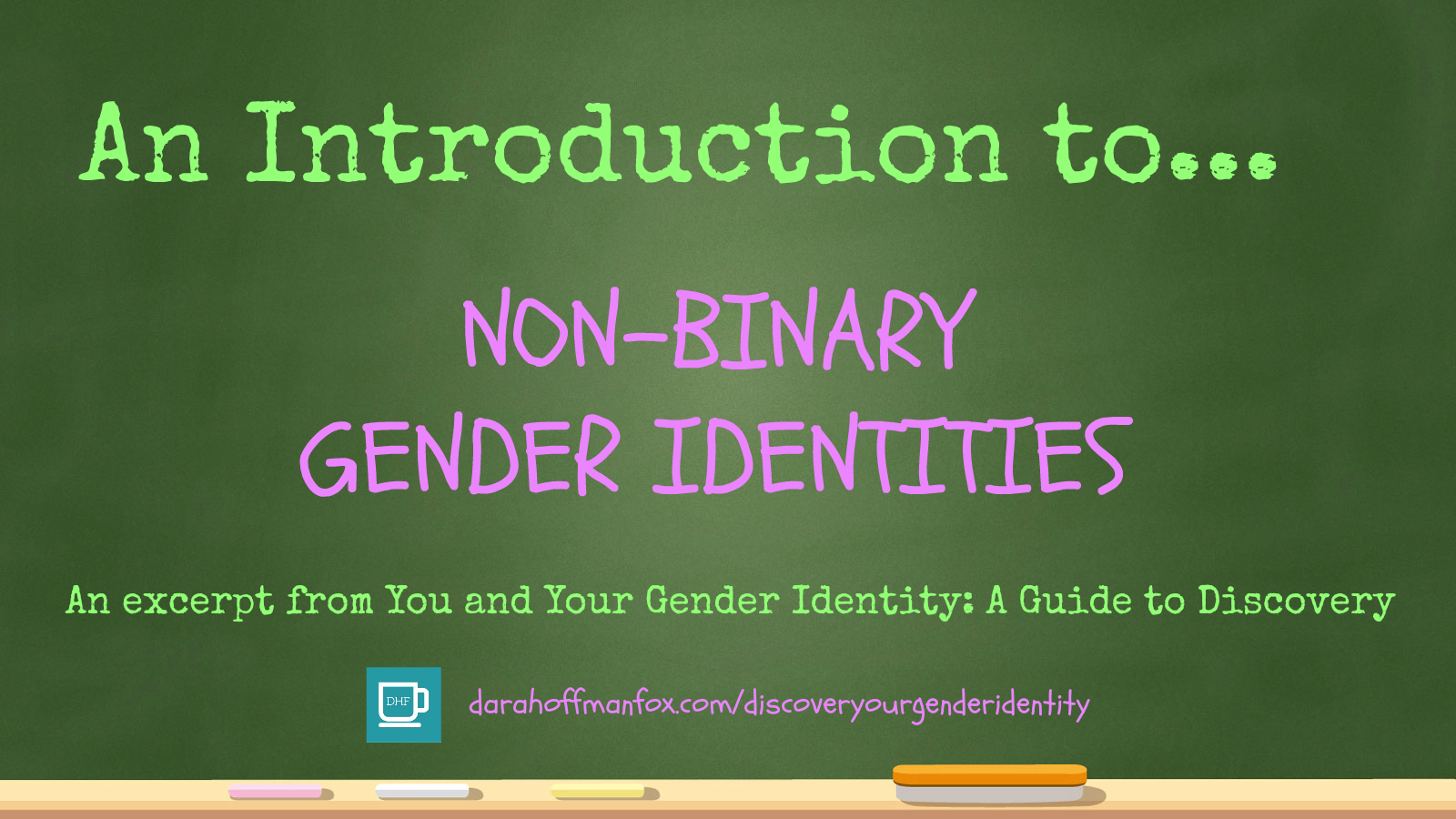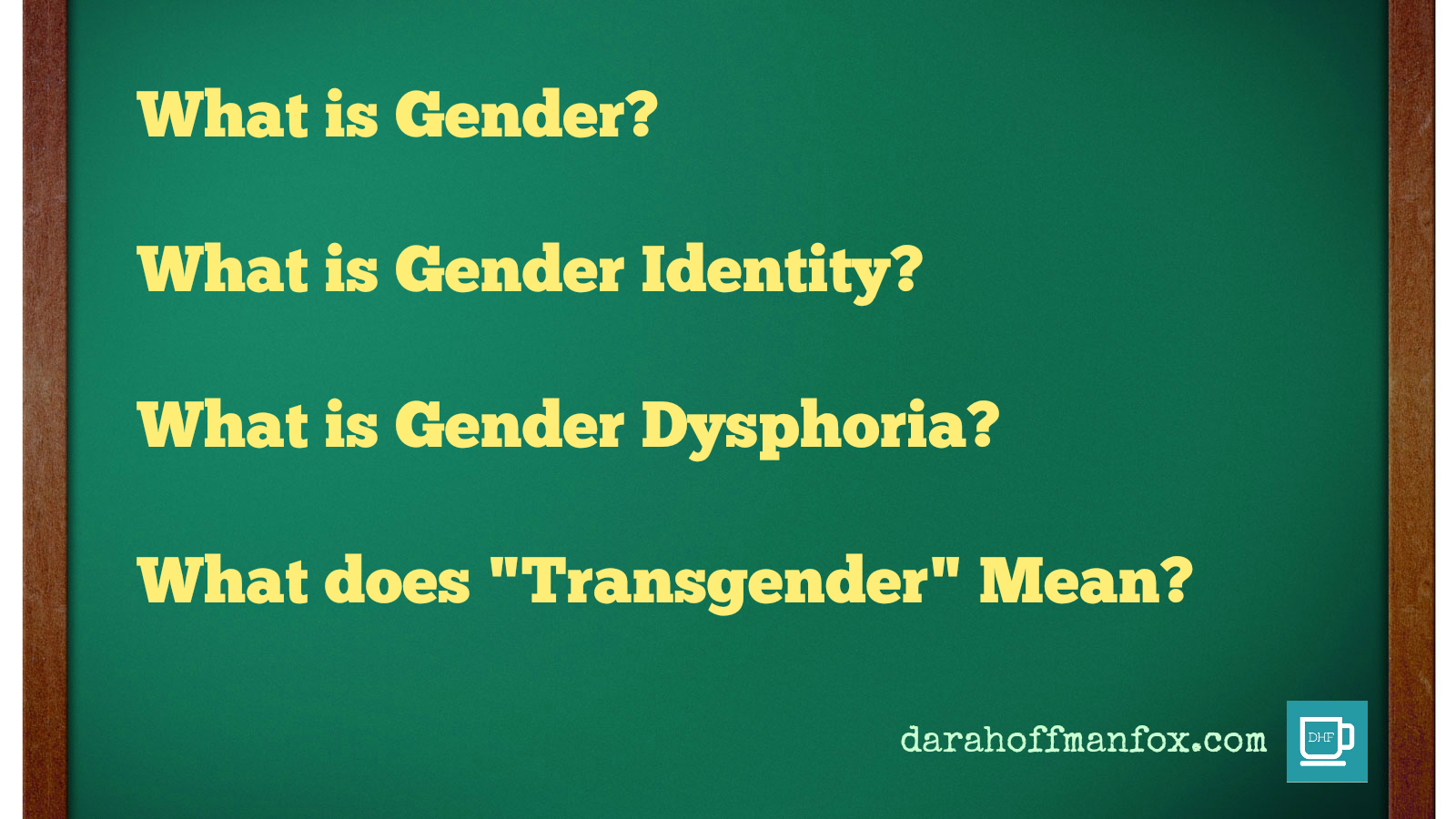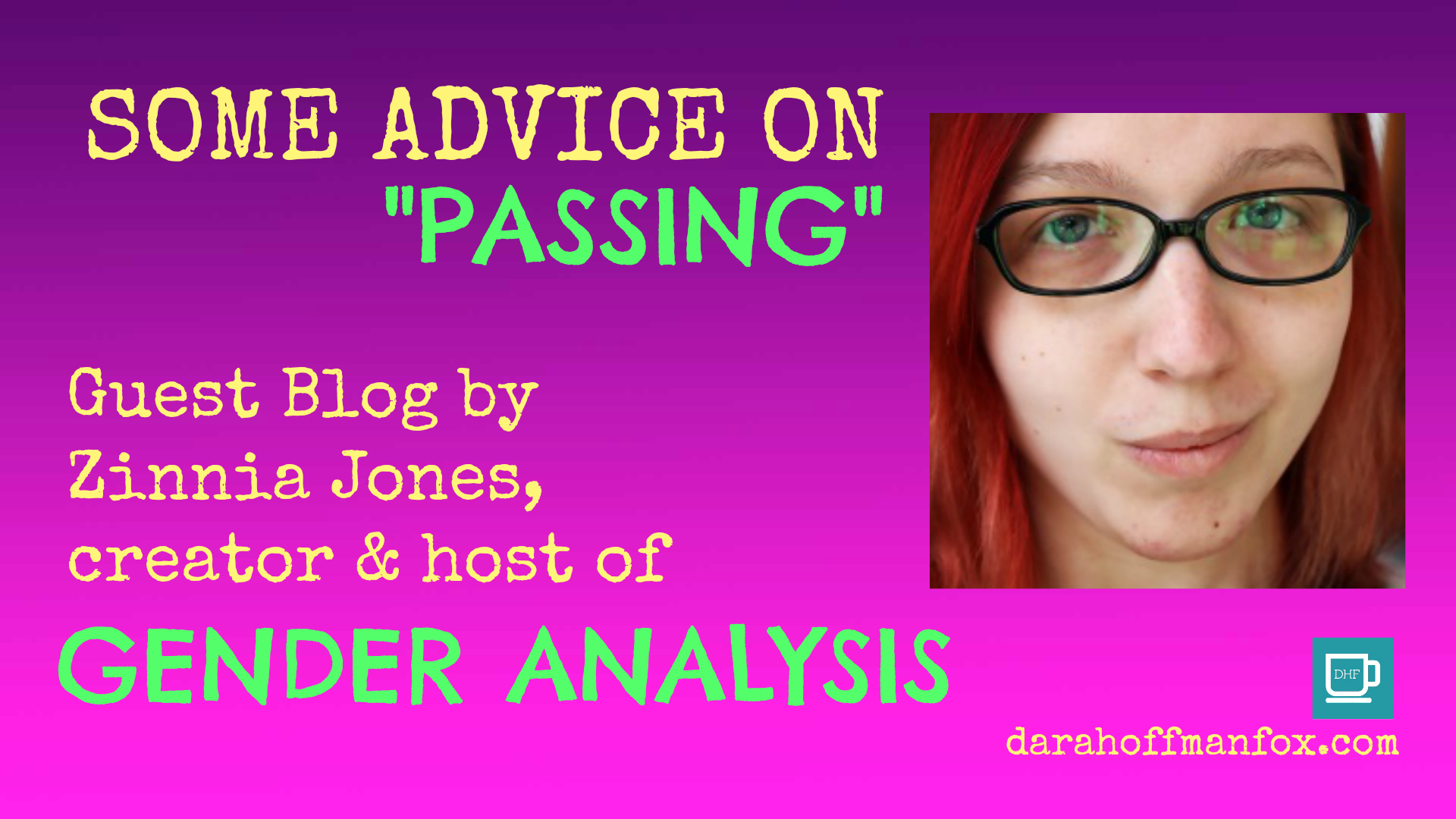An Introduction to Non-Binary Gender Identites
The following is one of the chapters from my book You and Your Gender Identity: A Guide to Discovery (released September 2017).
“Society seems to think there are only two valid options when it comes to gender – man or woman – when there are actually lots of other ways to embody gender, and even ways of having no gender at all.”
– Sam Dylan Finch
To best explain what it means to feel nonbinary, we’ll first need to define binary. The prefix bi means two. Therefore, concerning gender identity, binary refers to identifying as female or male, a woman or a man, a girl or a boy. As a gender identity, nonbinary means to feel uncomfortable identifying as either male or female. In other words, “Not feeling aligned with the sex and gender one was assigned at birth while also not feeling aligned with the ‘opposite’ gender.”[1]
It can be difficult for someone to put into words why they feel this way about their gender. They may only know what does and doesn’t feel “right” when something happens that reminds them of the discomfort they feel around their perceived gender. These reminders can happen constantly throughout the day, since gendered language is so ingrained into our society.
Nonbinary Identity Options
One of the beauties of having a nonbinary sense of one’s gender is endless range of ways gender can be experienced, described, and expressed. Nonbinary is an umbrella term with a multitude of options beneath it to choose from and explore.
Let’s look at a few of the general categories nonbinary identities can be broken into:[2]
- Agender: To feel as though you are without gender. Feeling as though gender is lacking within you, is undefinable, or unknowable. Agender can also be used as a way of stating you have no gender identity, and therefore nonbinary may not accurately describe your experience either.
- Androgyne: When your gender feels both masculine and feminine. This does not have to be an even split between masculine and feminine, nor does it have to remain the same combination at all times.
- Demigender: Feeling a partial connection to a gender identity. There are subcategories to choose from such as demiboy, demigirl, and demiandrogyne.
- Genderfluid/Genderflux: Variances in your gender over time. Which genders? That is up to the individual. Over how much time? How often? Again, that is up to each individual.
- Genderqueer: Can be used as either an umbrella or specific term. A place for those who feel existing terms fail to truly express their gender (or lack thereof). It is can also be used to describe the intersection of one’s gender identity, sexual orientation, and romantic orientation.
- Bigender: Feeling as if you are experiencing two gender identities simultaneously, or alternating between the two. These gender identities can be binary or nonbinary.
- Neutrois: To feel that your gender is neutral or null. A combination of the French words neutre (“neutral”) and trois (“three”).
- Pangender: Feeling that your gender is described by having all genders co-existing within yourself, including genders which have yet to be named, and perhaps will never be named. All of the genders do not have to be experienced at the same time and can be experienced more or less of the time than others.
- Third Gender: When individuals are categorized, either by themselves or a society, as being neither male nor female. Specific terms are used by certain societies that recognize there are three or more genders. Because this term is culturally and societally specific it is strongly advised that one looks into and reflects upon the cultural origins of these terms before identifying as such. {end bulleted list}
Within each of these categories, there are even more specific terms that can help you narrow down your particular experience with gender. Additionally, you can use as many terms as you want, in whatever combination you want. Nonbinary YouTuber thecharliecharmander suggests to “Think of it as using adjectives to describe your gender identity, instead of nouns.”[3]
Although this can sound liberating and full of possibilities, it can also sound a little confusing for some. Chapter 14 will walk you through the steps of choosing from these terms and piecing together your very own description of your gender identity.
How Do You Know If You Might Be Nonbinary?
Read through the following questions and place a checkmark in any of the boxes to which you would answer “Yes.” Keep in mind that answering “Yes” to any of these questions doesn’t mean you are undeniably nonbinary. It only means there’s something here worth exploring further.
- Do you feel uncomfortable being given only male or female as options? (e.g., checking either male or female on forms, restrooms, changing rooms, etc.)
- Do you shop in whichever clothes department you want, regardless of how the department is labeled (e.g., men’s department/women’s department)?
- Do you have difficulty finding clothes that fit properly, due to your body being shaped differently than the way gendered clothing is cut (e.g., trying on a shirt from the men’s department that won’t fit over your chest; trying on a dress from the women’s department that doesn’t look flattering on your frame type)?
- Do you dislike being addressed as either “sir” or “ma’am,” as well as gendered terms such as “ladies” or “fellas”?
- Do you wish you could be seen as whatever gender you feel like on any particular day?
- Do you wish there was no such thing as gender and would rather have nothing to do with it?
- Do you feel fine with whatever gender you are perceived as, maybe even getting a kick out of confusing others with how you are presenting?
- Do you have discomfort with being referred to as either “she” or “he”?
- Do you have no real attachment to being referred to as either “she” or “he”?
- Would you like to have the freedom to use gender-neutral terms to describe yourself, even when your gender is specifically asked for?
- Do you have a first name that is very gendered (i.e., very feminine or masculine) and feel it doesn’t suit you?
- Do you find it unpleasant to be presented with only two gender options, especially if you are expected to choose one of those based on the gender others assume you are?
- With regard to your sexual orientation, do you find it difficult to specify whether you are gay or straight because that means you are saying you are interested only in the “opposite” or “same” gender?
- Do you feel there are some aspects of who you are physically, socially, and hormonally that you are fine with and others that you are very uncomfortable with (as it relates to the gender you are perceived as)?
- Do you find yourself not wanting to be limited by gender when it comes to what you can be interested in, how you can act, how you dress, etc.?
If this exercise has begun to spark your curiosity, keep on reading. All of the exercises in this book were created keeping in mind the possibility that your gender identity may be nonbinary.
Possible Challenges with Being Nonbinary
It can be a big relief for someone to realize that they might identify as nonbinary if they had previously only been exposed to binary options of gender identity. On the other hand, societies will frequently show initial resistance to a new perspective about something that has been a long-standing tradition (in this case, the notion that are only two genders: male and female). This resistance can be conveyed as confusion, uncertainty, and discomfort toward the people who are having this experience. It can also result in a refusal to acknowledge their existence, as well as expressions of disrespect and disdain.
Keep in mind it is common, and even necessary, for a society to be introduced to new perspectives and struggle with them for a while. It’s as if a society is going through its own Hero’s Journey, initially pushing against the Call to Action it is receiving. Hopefully, over time, the society will come to an understanding that this new perspective is valid and therefore learn to embrace it as a genuine expression of the human experience had by many members of the society.
In much of the world, this is where we are concerning the verbalization of nonbinary gender identities. The existence of nonbinary gender identities is something that has only recently been put into words in many societies. This means it’s still in its infancy stage of being recognized and incorporated by these populations.
Here are challenges people who identify as nonbinary might come across when they are in the process of exploring and sharing this aspect of themselves:
- Exploring different gender identities over a period of time and having others say you are being confusing/that they don’t believe you.
- Not having many role models to choose from, whether in private or public life.
- Not seeing yourself represented in the mainstream.
- Wanting to use gender-neutral pronouns (such as they/them) and having issues with getting others to get to used it.
- Having difficulty finding resources, support, and stories of those who identity as nonbinary.
- Having your gender identity (or lack of gender identity) seen as invalid by those who are binary (i.e., “Pick a side”).
- Feeling like you don’t qualify as being transgender/trans.
- Not wanting to identify as transgender and/or nonbinary but having others say that you are.
- Encountering resistance if you decide to take medical steps to transition.
- Encountering resistance if you decide not to take medical steps to transition.
- Facing an increase in awareness that societies were often formed with “binary” as the only option.{end bulleted list}
Remember, if you identify as nonbinary, you are in the early stages of what is seen in many societies as a new perspective. It’s going to take time for everyone else to catch up, so be sure to find support and community for yourself along the way.
[1] Micah, “Non-Binary Transition,” (Neutrois Nonsense, n.d.), https://neutrois.me/non-binary-transition/.
[2] Nonbinary.org Wiki (Nonbinary.org, n.d.), http://nonbinary.org/wiki/
[3] Thecharliecharmander {channel], (YouTube, n.d.), https://www.youtube.com/user/thecharliecharmander.
Further Resources
These 5 Myths Might be Holding you back from non binary transition
Help! I Think I Might Be Non-Binary, But How Can I Know?
http://everydayfeminism.com/2015/03/non-binary-people-need-know/
http://everydayfeminism.com/2015/07/assumptions-non-binary-folks/
http://neutrois.me/2015/09/01/the-gender-playbook/
http://neutrois.me/2015/04/13/whats-my-gender/
http://nonbinary.org/wiki/Practical_Resources
http://neutrois.com/community/







Lauren Brooks
February 15, 2016 at 12:00 PMLove, love, love you, Dara and in fact have your #1 video pinned in our FB support group. 1 piece of constructive criticism >> I am exposed to many many feelings and opinions from other Transgender people,, with that, I have witnessed many who have a problem when someone uses the term ‘opposite’ gender,,,perhaps instead, you might consider phrasing it as ‘the other binary’ love you <3
Dara Hoffman-Fox
February 15, 2016 at 12:10 PMThanks for the feedback Lauren! I know what you mean about using the word “opposite” – I was hoping by putting it into quotes that it would help. I got the quote from a presentation given by Micah, who runs neutrois.me, and Micah made sure in the presentation to reiterate how they were using quotes around it for a reason. I’ll definitely think on it, thank you!
Krystopher
February 15, 2016 at 12:42 PMI think it can be confusing to put intergender and bigender in the same paragraph like that. Intergender and bigender are not necessarily interchangeable. Bigender is not commonly defined as “between male and female”. Instead, bigender is having two genders, specifically any two genders. Having your two genders be male and female is an example, but you can be male and genderqueer (like me!) or any other combination of two genders as well. And then it could be helpful to go on to say that some bigender people are always both of their genders, while others might switch, and there are still more bigender experiences not listed.
Dara Hoffman-Fox
February 15, 2016 at 10:44 PMThanks for the comment! The original information I got from gender.wikia.com/wiki/Gender_Wiki about it mentioned how intergender is used by many who are intersex and therefore something more like “bigender” should be used to express the same sentiment. I can see why it would be confusing.
Do you have a source I can site for a better definition of “bigender?”
Krystopher
March 4, 2016 at 8:46 AMNo problem~ The gender wiki already gives bigender its own page with an appropriate definition and explanation. http://gender.wikia.com/wiki/Bigender
Elle Denton
March 5, 2016 at 5:21 AMI’ve decided that I need no labels to know how I am. I guess that others need the labels for me so they can put me on a list they understand. Why can’t I just be Me.
Meaghan co Ray
March 18, 2018 at 12:24 AMHi Dara,
Just recently started listening to various trans podcasts and heard an interview where someone mentioned your book and then found your youtube channel and website. Great stuff in all areas.
I am AFAB, identify as gay since I was 14, then a year later, had an interesting spiritual/gender experience where I felt like I suddenly was given a male spirit in addition to my female one. For a little while I would flip back and forth between which one was dominant almost like they were fighting for supremacy so I sat down and found the commonalities between them and I have lived in the neutral space ever since. As I am AFAB and do still have a female spirit, I’m fairly comfortable still identifying as female. My spouse recently started transitioning (FTM) which has gotten me thinking more about my gender lately and I was searching terminology. I have always liked the term ‘two-spirit’ as that is literally what my experience has been and I grew up with a lot of native american culture. But seeing as I am not of aboriginal heritage, I have decided that is not a culturally appropriate term for me to use so instead, I found the term ‘co-gender’. This is two independent genders co-exiting in harmony with an experience/expression that is fluid between the two. For me, the two genders are male and female which leads to a generally neutral/androgynous experience but for others it could be any two genders/lack of genders.
Just wanted to add this term to the list as I also really appreciate having language to express myself to others and maybe someone else has an experience like mine and is struggling to understand it.
Thanks again for all your wisdom and content!!
Meaghan co Ray
Dara Hoffman-Fox
March 18, 2018 at 8:09 AM“Co-gender” will definitely now be added to any future list I use! Thank you for sharing your story 🙂